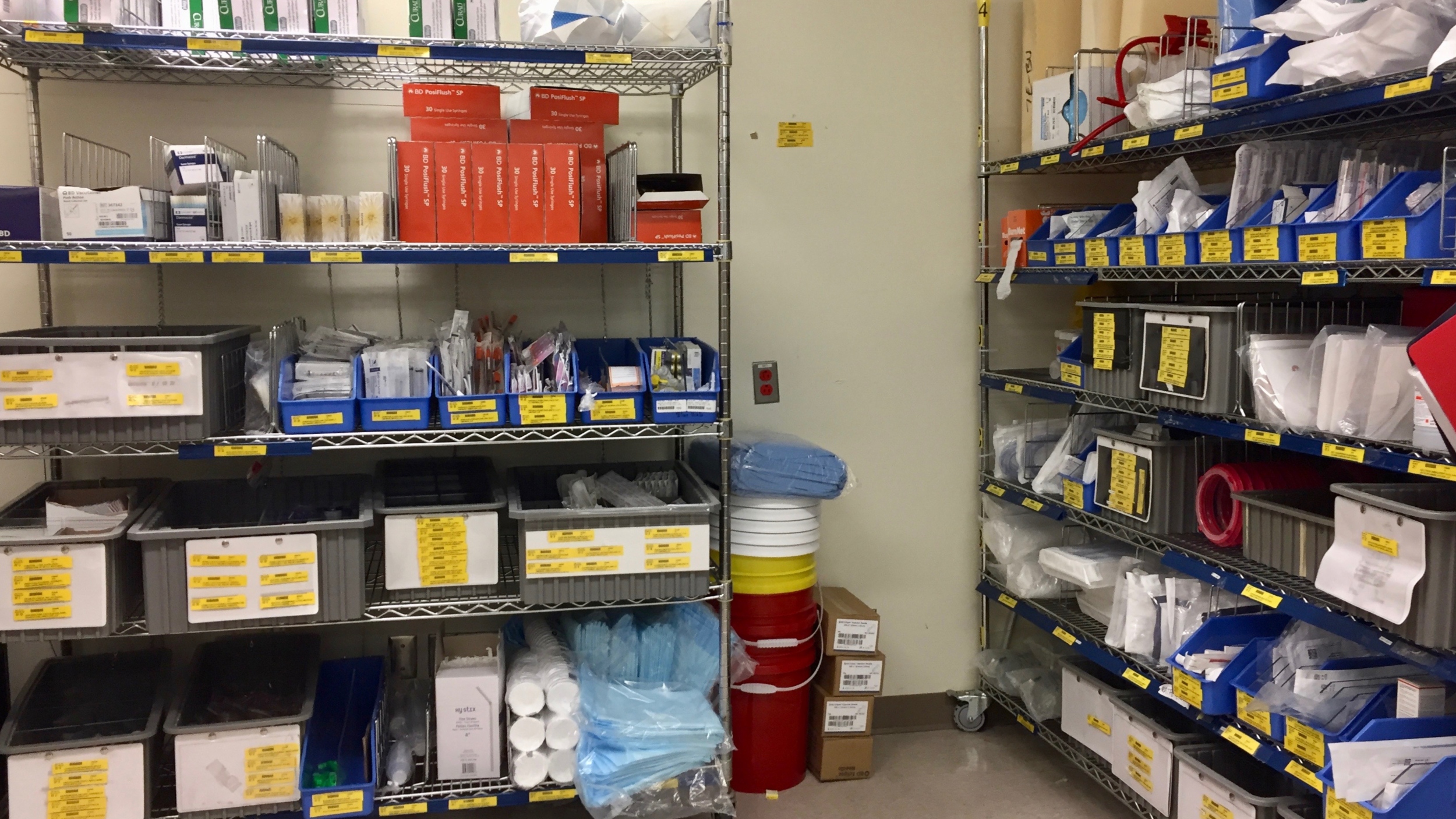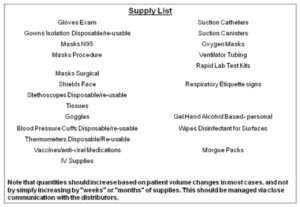Lessons Learned from the COVID Pandemic Part 2: Stockpiling!

In Part 2 of this series on pandemic planning, I am again “dusting off” portions of a study I wrote for the IBM Business of Government in 2011, titled “Planning for the Inevitable: The Role of the Federal Supply Chain in in Preparing for National Emergencies” that laid out important trends that were apparent as a result of the avian and H1N1 flu viruses that occurred in the global economy. This report established a number of lessons learned that need to be considered and implemented into the fabric of federal, state, and local governments, as we go into a recovery mode in the next months and years. Today, we focus on the third set of actions needed, that is sorely missing today: strategic stockpiling!
Stockpiling supplies is one of the most often-cited strategies associated with pre-pandemic planning, and the failure of states and the federal government to maintain a national stockpile prior to the current panic is obvious to everyone. However, the private sector should also consider developing stockpiling strategies in their own business continuity planning cycles, even though there is a cost to doing so. The cost of stockpiling is not insignificant, and requires an investment in products that go into inventory that may or may not be utilized in the short term. Typical inventory holding costs are in the range of 18-25% of the value of a good on an annual basis, and includes opportunity costs, storage, interest, insurance, shrinkage, and obsolescence, Questions surrounding supply chain pandemic stockpiling of goods include the following:
- What types of supplies are required?
- Who are the critical individuals who should receive medications first?
- What is the right quantity of supply?
- What is the relative cost of supply?
Stockpiling ahead of an actual pandemic such as this one is an important strategy, and is made even more critical given the length of time required to develop and distribute vaccines. The length of time to isolate a strain and develop a vaccine is often six months or more, so organizations should rely on other forms of prevention in the short-term. Interviews with key experts also reveal that once a vaccine is identified and isolated (which could take 6 to 12 months), the actual vaccine treatment requires two shots, spaced 21 days apart, which further lengthens the response time.[1]
Table 1 – Framework for Assessing Maturity of Preparedness for Pandemics (Far Left is Most Mature, Far Right is Least Mature)

The actual maturity of governments to prepare strategic stockpiles is shown in the maturity model in Table 1. Based on this assessment, it is fair to say that most governments have been largely unprepared. The shortage of masks and the lack of medicines to treat the virus, as well as the shortage of medicines for hospitals, is horribly apparent if one looks at the news.
Table 2 – Stockpile Supply List
 A complete supply list of stockpiling supplies is shown in Table 2 to the left. The most important supplies identified as important for stockpiles fall into 4 categories.
A complete supply list of stockpiling supplies is shown in Table 2 to the left. The most important supplies identified as important for stockpiles fall into 4 categories.
- Hand sanitizers (mostly alcohol-based) – the use of hand sanitizers will kill viruses that are spread through shaking hands, touching of surfaces, and food preparation. However, they do not eliminate viruses, and impact is temporary.
- Masks: all types (procedural, N95, non-approved by NIOSH) – masks are the single most effective method of preventing the spread of pandemic virus, as they eliminate the inhalation via air-borne transmission. However, transmission through contact by hand to the nose or eyes is still possible.
- Vaccines – The main reason for vaccinating workers in critical infrastructure sectors, is not to reduce general absenteeism, but rather to protect workers whose absence would slow or stop critical functions and also to protect workers at especially high occupational risk. However, most private enterprises have already moved forward with their own independent pandemic plans, as they are not willing to risk exposure to the enormous economic impacts of a pandemic to their business, and are not willing to let their destiny be determined by federal, state, or local agencies. This reflects a fundamental mistrust of state and local governments to be able to effectively deploy pandemic anti-viral and vaccines, which is perhaps well-placed given the uncertainties surrounding the distribution plans of federal and state agencies. This is already becoming sore point in the current pandemic, as tensions could arise as to whether private enterprises need to make available their private stockpiles of supplies to local agencies. There is no strong governance around who is in control. Although vaccines are the preferred approach to allow critical infrastructure workers to proceed, it could be awhile before we see them. Vaccine development will likely take a year or more to produce a pre-pandemic anti-viral strain, and are not always a good match. To be fully effective, vaccines need to be produced from the original covid virus, which means that the first wave of illness will hit prior to development. There is also guidance on prioritization of vaccines by population groups. It should also be noted that there are several potential supply chain bottlenecks that can occur, including cell-culture technology such as single-use equipment, high throughput instruments and analytic tools, specialty filters, single-use bags and disposable components, and availability of fill-finish capacity, syringes, and vials. According to the WHO Pandemic Preparedness Plan, flu manufacturers would have to double their existing capacity to meet pandemic demand, and it requires 5 years to construct a vaccine-manufacturing plant. Finally, a shortage of refrigerated storage and transportation providers, lab technicians, and other professions is expected if a global vaccination is to occur.
- Antiviral drugs –These drugs reduce the duration of infection and transmission. Many organizations have expanded their manufacturing capacity significantly in the last few years in advance of pandemic planning and orders for anti-virals from across the globe. In the case of COVID, it is unclear if anti-virals have any effect, and there are multiple therapies being sought to treat the symptoms and effects of the virus.
Our research results point to several important “best practices” that enterprises should consider in establishing necessary stockpiling approaches. As shown in Table 1, more mature organizations have developed sophisticated approaches to measuring and deploying stockpiles. As noted earlier, the costs of doing so are not insignificant. As such, we developed a cost model to identify the different costs of stockpiling, which identifies the approximate total cost of stockpiling supplies, relative to the lost wages and productivity associated with employee illness. The model requires a pandemic supply chain team to first identify the relative cost to enter the approximate cost of different medical stockpile items, including face masks, wipes, antivirals, gloves, and antimicrobials (see Table 3). Next, the calculator requires the company to identify employees as either low risk or high risk, based on the criticality of their role in the company. Medium or high risk employees may consume a greater amount of supplies that low risk employees, and inventory levels will need to be adjusted to account for this.
Table 3 – Cost Model for Preparedness
| SWINE FLU PREPAREDNESS – MEDICAL SUPPLIES | ||||
| S. No | Item | Box Cost ($) | Box of (no.s) | Unit Cost ($) |
| 1) | Masks | |||
| Ordinary face mask | 16.45 | 50 | 0.33 | |
| N95 – Particulate respirator mask | 31.85 | 10 | 3.19 | |
| 2) | Wipes | |||
| Surface Disinfectant Wipe | 16.45 | 65 | 0.25 | |
| Antimicrobial Hand Wipe | 121.00 | 12 | 10.08 | |
| 3) | Antivirals | |||
| Tamiflu | 97.99 | 10 | 9.80 | |
| Relenza | 69.00 | 20 | 3.45 | |
| 4) | Gloves | |||
| Nitrile Powder-Free | 6.95 | 100 | 0.07 | |
| Sterile Examination Gloves | 27.45 | 40 | 0.69 | |
| 5) | Antimicrobials | |||
| Hand Sanitizing Gel (120 ml) | 1.95 | 1 | 1.95 | |
| Liquid Soap (800 ml) | 4.35 | 1 | 4.35 | |
| 6) | Vaccine | |||
| Estimated COVID vaccine – wholesale acquisition cost for one dose of vaccine (based on historical vaccine costs) | – | – | 20* | |
| Cost of Nurse’s time to screen an employee and administer the vaccine | – | – | 2.3# | |
| Costs of disposable syringe, alcohol wipes, bandage | – | – | 0.25^ | |
| Sources: | http://www.osha.gov/dsg/guidance/stockpiling-facemasks-respirators.html | |||
| http://www.allegromedical.com/swine-flu-c7240.html | ||||
| http://www.westcoastdrugs.net/generic-medicine/Tamiflu/327.html | ||||
| http://www.medicalnewstoday.com/articles/162998.php | ||||
| http://www.fluology.com/cost-calc.html | ||||
As shown in Table 4, the cost of protecting a low risk employee for 5 days is approximately $45, and $115 for a medium or high risk employee. On average, the cost per employee for an enterprise of $500 people is $80 per employee, versus a total cost of lost productivity and wages of $3544. This is an investment recovery of 44 to 1, just based on employee absenteeism costs, and does not include other costs such as lost sales, customer impact, brand name, etc. Given the challenges of pandemics and the risk to enterprise value, this is an investment well worth considering.
Table 4 – Total Cost of Protecting an Employee
| TOTAL COST OF PROTECTING AN EMPLOYEE (for 5 days) | Avg (in USD) | ||
| Low risk level | 45.62 | 80.33 | |
| Medium risk level | 115.03 | ||
| High risk level | |||
| TOTAL COST OF PROTECTING AN EMPLOYEE (for 5 days) – (USD) | 80.33 | ||
| TOTAL COST OF ABSENTEEISM PER EMPLOYEE (ACE) – (USD) | 3,543.75 | ||
| INPUTS | |||
| Average annual salary | AS | 30000.00 | USD |
| Average monthly salary | AM | 2500.00 | USD |
| Total Employee hours lost to absenteeism | ML | 40.00 | hours |
| Weighted Average Hourly Pay (for various occupational groups) | WH | 15.63 | USD |
| Cost of Employee benefits per hours per employee | EBC | 5.47 | USD |
| Supervisor hours lost in dealing with absenteeism | S | 50.00 | hours |
| Average hourly pay for supervisors | RH | 40.00 | USD |
| Costs of supervisor benefits | SBC | 14.00 | USD |
| Other Costs | OC | USD | |
| Total Employees | E | 250.00 | people |
Further, social distancing training may need to be established for workers who are to work from home. Robust work from home programs should include distribution of secure laptops, internet, and of course, the ubiquitous Zoom or Webex technology…
[1] Interview with CDC Official, July 14, 2008.


